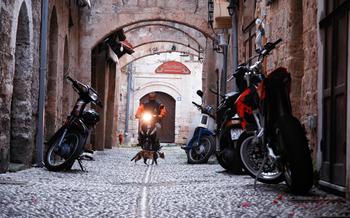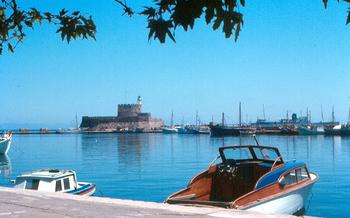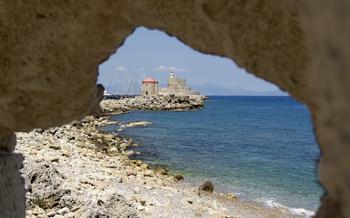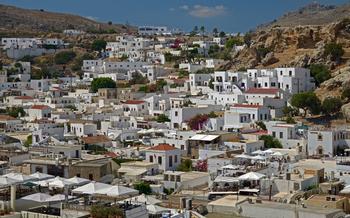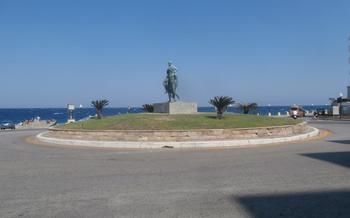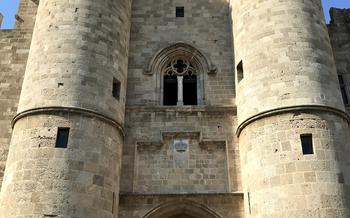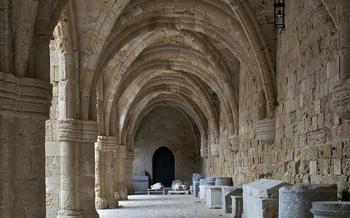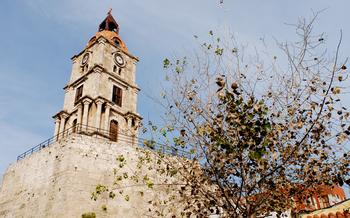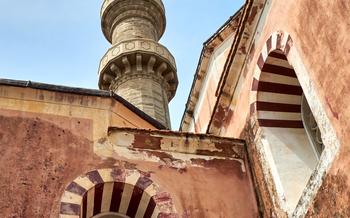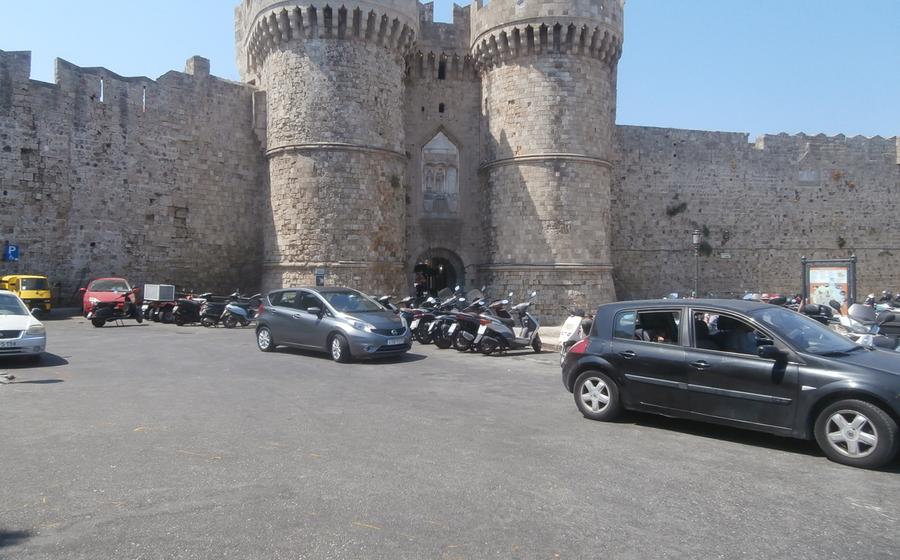
Marine Gate
- Historical Significance
- Architectural Features
- Location and Surroundings:
- Visiting Information
- The Knights' Quarter
- The Old Town of Rhodes: A UNESCO World Heritage Site
- The Colossus of Rhodes:
- Byzantine and Ottoman Influences:
- Exploring the Old Town
- The Acropolis of Rhodes: An Ancient Citadel
- The Valley of the Butterflies
- The Beaches of Rhodes
- The Cuisine of Rhodes
Historical Significance
The Marine Gate, also known as the Sea Gate, has played a pivotal role throughout Rhodes' rich history. In ancient times, it formed part of the city's fortifications, protecting it from seaborne invasions. During the medieval era, it served as a crucial entrance for the Knights of St. John, who transformed Rhodes into a formidable stronghold. Under Ottoman rule, the gate underwent modifications to accommodate their military needs, reflecting the city's changing political landscape. In recent times, the gate has been meticulously preserved and restored, standing as a testament to Rhodes' enduring heritage and resilience.
Architectural Features
The Marine Gate stands as a testament to the architectural prowess of its builders. Its design showcases a blend of defensive and aesthetic elements, creating a structure that is both formidable and visually striking. The gate features multiple gates and towers, each serving a specific purpose in the city's defense. The main entrance is flanked by two imposing towers, which provided a vantage point for guards to survey the surrounding area and repel attackers. The gate also incorporates a series of smaller gates and posterns, allowing for controlled access and escape routes in times of danger.
The gate's fortifications are a testament to its defensive capabilities. Surrounding the structure is a moat, which served as a barrier against enemy forces and made it difficult for them to approach the gate. The gate is further protected by a series of ramparts and crenellated walls, providing additional defense against attackers. The walls are adorned with decorative elements such as machicolations and merlons, which not only added to the gate's aesthetic appeal but also served a practical purpose by allowing defenders to drop objects on attackers below.
Location and Surroundings:
The Marine Gate holds a strategic position within the medieval city walls of Rhodes, serving as the main entrance to the Old Town. Situated at the northwestern end of the city, it allowed access to the Mandraki Harbour, once home to the famed Colossus of Rhodes, one of the Seven Wonders of the Ancient World. The gate's proximity to the harbour made it a crucial point of entry for trade and travel, contributing to Rhodes' prosperity as a maritime power.
Beyond its strategic importance, the Marine Gate also stands as a testament to the city's rich history. The Old Town, which surrounds the gate, is a UNESCO World Heritage Site, renowned for its well-preserved medieval character. Narrow cobblestone streets, adorned with traditional whitewashed houses and Byzantine churches, invite visitors to step back in time and experience the charm of a bygone era.
Visiting Information
The Marine Gate is easily accessible on foot, as it is located within the Old Town of Rhodes. For those using public transportation, the nearest bus stop is located just outside the gate, providing convenient access from various parts of the city. The gate is open to the public throughout the day, offering unrestricted access to visitors. While there is no admission fee required to enter the gate, guided tours are available for those who wish to delve deeper into its history and significance. These guided tours often provide insights into the gate's defensive features, architectural details, and its role in Rhodes' rich history. With its open accessibility and informative guided tours, the Marine Gate welcomes visitors to explore its grandeur and immerse themselves in the captivating history of Rhodes.
The Knights' Quarter
The Knights' Quarter holds immense historical significance in Rhodes. Established by the Knights of St. John in the 14th century, this fortified area served as the administrative and residential center of the Order. Located just a short walk from the Marine Gate, the Knights' Quarter is a captivating blend of medieval architecture, cultural heritage, and historical charm.
Among its notable landmarks is the magnificent Palace of the Grand Master, an architectural masterpiece that once housed the Order's Grand Master. With its imposing presence, intricate carvings, and stunning courtyards, the palace stands as a testament to the Knights' power and influence.
Other architectural highlights include the Church of Our Lady of the Castle, with its Gothic-style architecture and impressive stained-glass windows, and the Street of the Knights, a picturesque cobblestone lane lined with medieval inns and mansions that once belonged to the Knights.
Beyond its architectural treasures, the Knights' Quarter is home to several cultural attractions. The Archaeological Museum of Rhodes houses a rich collection of artifacts from the island's ancient past, including sculptures, pottery, and jewelry. The Museum of Modern Greek Art showcases works by renowned Greek artists, providing a glimpse into the country's contemporary art scene.
Exploring the Knights' Quarter is like stepping back in time, immersing yourself in the grandeur and legacy of the Knights of St. John. Every corner holds a story, every stone bears witness to a rich and fascinating history.
The Old Town of Rhodes: A UNESCO World Heritage Site
The Old Town of Rhodes, where the Marine Gate stands as a proud sentinel, is a captivating tapestry of history and culture. Recognized as a UNESCO World Heritage Site, this enchanting quarter exudes an aura of medieval charm, inviting visitors to step back in time.
Strolling along the labyrinthine cobblestone streets, one is greeted by an array of architectural wonders that showcase the Old Town's rich heritage. Fortified walls and imposing gates, remnants of the city's defensive past, stand alongside graceful churches, elegant mansions, and bustling shops. Each corner reveals a hidden gem, from quaint courtyards adorned with vibrant bougainvillea to traditional tavernas serving mouthwatering local delicacies.
The Old Town is not merely a museum piece; it is a living, breathing community where the past and present harmoniously coexist. Locals go about their daily lives, preserving traditions that have been passed down through generations. Visitors can immerse themselves in this vibrant atmosphere by exploring the bustling markets, sampling traditional cuisine, or simply sipping a cup of coffee at a charming outdoor café.
Whether you're a history buff, an architecture enthusiast, or simply someone who appreciates the beauty of ancient cities, the Old Town of Rhodes promises an unforgettable journey through time.
The Colossus of Rhodes:
The Marine Gate offers a direct connection to one of the most captivating wonders of the ancient world, the Colossus of Rhodes. This monumental bronze statue, standing over 100 feet tall, was one of the Seven Wonders of the Ancient World and a symbol of Rhodes' maritime power. Though destroyed by an earthquake centuries ago, its legacy lives on, and visitors can still marvel at its former grandeur through historical accounts, legends, and modern interpretations.
The Colossus was strategically placed at the entrance of Mandraki Harbour, serving as a beacon of guidance and protection for seafarers. Its colossal size and intricate craftsmanship made it a sight to behold, attracting visitors from distant lands. While the original statue no longer stands, its enduring fame and significance continue to captivate the imaginations of travelers to this day.
In recent years, there have been discussions and proposals to recreate the Colossus in some form, using modern engineering and materials. While the exact details and feasibility of such a project remain uncertain, the idea of witnessing a modern interpretation of this ancient wonder is certainly intriguing and could potentially add another layer of fascination to the already captivating allure of Rhodes.
Byzantine and Ottoman Influences:
The Marine Gate, like many structures in Rhodes, showcases a blend of Byzantine and Ottoman influences, reflecting the island's rich cultural heritage. During the Byzantine era, Rhodes flourished as a center of Christianity, leaving an imprint on the gate's architectural style. Elements such as intricate carvings, decorative arches, and mosaic patterns can be attributed to Byzantine craftsmanship.
Following the Ottoman conquest in the 16th century, Rhodes underwent significant changes. The Ottomans fortified the city, adding imposing towers and bastions to the Marine Gate. They also incorporated Islamic architectural elements, such as pointed arches and domes, which can be seen in the gate's upper sections.
This fusion of Byzantine and Ottoman influences is a testament to Rhodes' diverse past. The Marine Gate stands as a symbol of the island's resilience and the cultural exchange that occurred throughout its history. Visitors can explore the gate and other landmarks in Rhodes to discover the layers of history and cultural heritage that make this island so captivating.
Exploring the Old Town
To fully immerse yourself in the charm of Rhodes' Old Town, embark on a guided or self-guided walking tour. These tours will take you through the labyrinthine streets, revealing hidden gems and historical landmarks. Discover the Palace of the Grand Master, the Street of the Knights, and the Suleyman Mosque, each narrating a chapter of Rhodes' rich history.
Venture off the beaten path to uncover hidden courtyards, charming cafes, and local shops tucked away in the narrow alleys. Get lost in the vibrant atmosphere of the Old Town, where the scent of freshly baked bread wafts from traditional bakeries, and the sound of clinking glasses echoes from tavernas.
Indulge in the local cuisine by trying traditional dishes such as moussaka, souvlaki, and the famous meze platters. Visit the central market to sample fresh produce, spices, and local delicacies. Don't forget to treat yourself to a scoop of delicious Greek yogurt topped with honey and walnuts—a perfect way to end your culinary exploration of Rhodes.
For those seeking unique souvenirs, the Old Town offers a treasure trove of local shops and markets. Find handmade ceramics, intricate jewelry, and traditional textiles that reflect the island's rich heritage. Whether you're looking for a piece of art, a gift for a loved one, or a memento of your time in Rhodes, you'll surely find something special amidst the vibrant stalls.
The Acropolis of Rhodes: An Ancient Citadel
Perched atop Monte Smith, the Acropolis of Rhodes stands as a testament to the island's rich ancient past. This fortified hilltop served as a sanctuary and a religious center in antiquity, housing several temples dedicated to various deities. Archaeological excavations have unearthed the remains of these temples, offering a glimpse into the religious practices of the ancient Rhodians.
Visitors can explore the ruins of the Temple of Apollo, once the most prominent temple on the Acropolis. Other notable structures include the Odeon, a small theater used for musical performances, and the Stadium, where athletic competitions were held.
The Acropolis also boasts breathtaking panoramic views of Rhodes, making it a popular spot for visitors seeking to capture the island's beauty. From the hilltop, one can admire the stunning coastline, the medieval Old Town, and the distant Turkish mainland.
The Valley of the Butterflies
Nestled in the scenic village of Theologos, just a short drive from Rhodes Town, lies a natural wonder that attracts visitors from around the world – the Valley of the Butterflies. This unique ecological reserve is home to a diverse array of butterfly species, creating a captivating spectacle of fluttering wings and vibrant colors.
As you enter the valley, the air becomes alive with the gentle fluttering of thousands of butterflies. The lush greenery provides a tranquil setting for these delicate creatures to thrive, with cascading waterfalls and meandering streams adding to the serene atmosphere.
Take a leisurely stroll along the nature trails that wind through the valley, immersing yourself in the tranquil beauty of this natural paradise. Observe the butterflies as they dance gracefully from flower to flower, showcasing their intricate wing patterns and vibrant hues.
Spend a relaxing afternoon enjoying a picnic amidst the tranquil surroundings of the valley. Capture stunning photographs of the butterflies as they flutter and dance, creating unforgettable memories of your visit to this enchanting natural attraction.
The Beaches of Rhodes
Rhodes boasts a stunning array of beaches, each offering unique experiences and breathtaking views. Whether seeking secluded coves, lively beach clubs, or pristine stretches of sand, Rhodes has something for every beach lover.
The island's most famous beach, Tsambika Beach, is renowned for its crystal-clear waters, soft golden sand, and picturesque setting. Surrounded by lush greenery and towering cliffs, Tsambika offers a serene escape from the hustle and bustle of city life.
For those seeking a more lively atmosphere, Faliraki Beach is the place to be. This vibrant stretch of coastline features numerous beach clubs, water sports facilities, and restaurants, ensuring a fun-filled day under the sun.
If you prefer secluded coves and tranquility, Anthony Quinn Bay is a hidden gem waiting to be discovered. Nestled between towering cliffs, this picturesque bay offers crystal-clear waters ideal for swimming, snorkeling, and diving.
For those who enjoy water sports, Ixia Beach is a paradise. With its consistent winds and waves, this beach is a popular spot for windsurfing, kitesurfing, and sailing.
No matter your preference, Rhodes' beaches offer an unforgettable experience. Whether you seek relaxation, adventure, or a combination of both, you'll find your perfect beach on this enchanting island.
The Cuisine of Rhodes
Rhodes' cuisine is a delightful blend of Greek and Mediterranean flavors, influenced by its rich history and cultural diversity. Traditional Rhodian dishes showcase fresh local ingredients, with an emphasis on seafood, vegetables, and herbs. One must-try dish is "mousakas," a hearty casserole made with layers of eggplant, potatoes, ground beef, and a creamy béchamel sauce. "Dolmades," stuffed vine leaves with rice, herbs, and sometimes minced meat, are another popular delicacy. For a taste of the sea, try "garides saganaki," succulent shrimp cooked in a tomato and feta cheese sauce. Don't forget to sample the local cheeses, such as "mizithra," a soft white cheese, and "lachani," a hard yellow cheese made from sheep's or goat's milk. Accompany your meal with a glass of Rhodian wine, known for its fruity and aromatic character. To fully immerse yourself in the culinary delights of Rhodes, consider taking a cooking class and learning how to prepare traditional dishes like a local.
